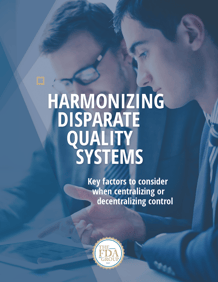This article is an excerpt from our free white paper, Harmonizing Disparate Quality Systems. Click here to get the full guide, a comprehensive resource for navigating quality issues during mergers and acquisitions.
Success or failure in absorbing a company’s quality system weighs heavily on the due diligence performed by company and department leaders to inform their decisions during the process. While it’s impossible to offer universally-sound advice for a set of tasks so specific to each situation, the steps for integrating a quality system usually follow a familiar pattern:
Regulatory and Quality personnel are deployed to examine 510(k)s, device listings, and labeling to ensure everything is in accordance with regulatory requirements—identifying gaps as they go along. Any gaps that are identified are then addressed as a part of the transition plan.
Similarly, quality personnel are tasked with examining procedures, vendors, and vendor agreements, as well as devised histories and match records. They, too, conduct a gap analysis to reveal any holes in the quality system—and just as importantly—any areas where records and documentation aren’t closely mapped onto the quality system currently in use. The resulting gap analysis is accompanied by a remediation plan designed to ensure everyone is comfortable moving forward.
At this point, companies must make a critical decision: leave the quality system largely as-is, or make the fundamental changes necessary to bring them into their own.
We've highlighted a few pros and cons for each of these paths to help you understand which fits best with your particular situation.
Quality System Decentralization
The Pros
- It’s easy on operating divisions. From the perspective of the organization coming under a new corporate umbrella, a well-performing quality system which isn't in need of many significant changes offers immense relief to the incoming quality team. While this may seem like a simple point, mergers and acquisitions inevitably bring some degree of change to an operating division. Reducing unnecessary changes can help teams focus on what matters most during times of change and reorganization.
- Fewer risks associated with making fundamental changes. Imposing fundamental quality systems on new operating divisions can be traumatic to a recently acquired quality team. In instances where these changes are necessary, corporate entities should be aware of the potential consequences, including vacated positions.
The Cons
- Opportunities for problems to go, and grow, unnoticed. Even the best quality systems can receive poor inspection outcomes when relentless investigators invest hours or even days searching for problems to satisfy a Form 483. Other times, it’s just the opposite. A quality system riddled with holes (perhaps good procedures poorly implemented) could be subject to an inspection from an investigator who ignores serious problem indicators by only reading a couple procedures, looking through some documents, and heading out—resulting in a dangerously misleading clean bill of quality system health. This can prompt some to see the lack of observations as proof of a compliant quality system when in fact, issues are silently growing.
“Despite the best intentions of regulators, inspection outcomes are typically influenced far more by the demeanor of the person or people inspecting you than to the system that they’re investigating.”
 Larry Stevens, RAC
Larry Stevens, RAC
Organizations with decentralized quality systems run the risk of finding themselves in this nightmare scenario. In short, corporate offices judging their divisions’ quality system compliance by their ability to get through audits by ISO or FDA, can’t be confident that problems aren’t hiding under the surface.
While it’s easy to gravitate toward an “if-it-ain’t-broke-don’t-fix-it” mentality regarding changes to the quality system, many companies further inform their decisions through inspections led by internal or external quality professionals before final release. While the value of such thorough initial evaluation may be hard to see in the short term, the long-term value can’t be overstated in the context of the rapidly changing regulatory landscape.
Now, more than ever, what may seem like an insignificant issue today may grow to become a serious compliance problem tomorrow. An investment in smart prevention now pales in comparison to the costs of correction later.
Quality System Centralization
The Pros
- Lower costs. Corporate finance teams usually favor centralization because it’s cheaper. If you’re going to take all the divisional purchasing departments out and put up a corporate purchasing function, it ultimately saves the company money. In the RA/QA area, however, centralization is more an issue of ensuring that standards for quality systems are in place at all operating divisions. That means defining, fairly specifically, the kinds of procedures they need and what they should contain. Additionally, teams should put intense focus on the successful interoperability of all computer systems being used and the quality system.
The Cons
- Heavy workloads for the incoming company. Quality system centralization can saddle incoming teams with considerable work, which can seem particularly frustrating when an otherwise strong quality system must undergo purely structural changes simply for the sake of it being centralized. Teams must go back and revise procedures, retrain staff, and face a steep learning curve that can upset organizational relationships and dynamics in ways that aren’t always apparent to the leaders imposing the actions.
- Possible personnel losses. It’s important to be aware that depending on the degree to which systems and procedures are being changed, RA/QA personnel may leave the company in reaction to sudden and fundamental shifts.
The complexity of full quality system integration can be a massive task, but companies whose quality management systems are reliant on the use of a large, standardized system may have no choice but to undertake it. Following a thorough gap analysis, company and department leaders must commit to change the quality system over completely. This, of course, in no small task and must carefully be planned and implemented.
“Large systems can require full integration with the company. That’s a big deal, but we've done it. I've actually been the plant QA manager when we've done it. It’s difficult, but it’s certainly been done before.”  Rich Wynkoop
Rich Wynkoop
→ The FDA Group offers the expertise of former FDA personnel to help ensure quality system compliance. Contact us to learn more about how we can help, or grab our free white paper below for a comprehensive guide to answering the major quality system harmonization questions that arise during a merger or acquisition.
Harmonizing Disparate Quality Systems: A Free White Paper
Key factors to consider when centralizing or decentralizing control



